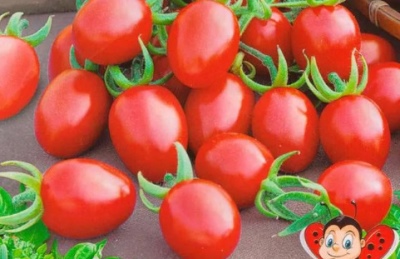
- Category: hybrid
- Growth type: determinant
- Appointment: fresh consumption, for whole fruit preservation
- Ripening period: mid-season
- Ripening time, days: 105-110
- Bush size: medium-sized
- Bush height, cm: 120-140
- Ripe fruit color: Red
- Fruit weight, g: 9-14
- Number of fruits in a brush, pcs: several dozen fruits in each
Cherry waterfall tomato is a new domestic hybrid that is still little known to Russian gardeners. Differs in high resistance to many diseases of tomatoes, unpretentiousness to different weather conditions. Mini-tomatoes are used fresh, for preservation individually or with whole brushes, dried and dried, used for decorating dishes. Plants can be used to decorate your home and front garden.
Not to be confused with the Cherry Falls variety.
Breeding history
The hybrid was bred by the breeding nursery of Agrofirma Aelita LLC.
Description of the variety
The bushes are compact, medium-sized in height, reach 120-140 cm, the stems are strong, narrow, medium-leafy, the leaves are small oval-shaped, bright green. The type of bush is determinant. The growth of the main shoot is limited to the inflorescence at the top. The first brush is laid over 6-7 sheets, then after 1-2 sheets. Each flower forms an ovary. The fruits are tied even with cold snaps and temperature drops. The brushes are large, simple type - one can contain from 10-15 fruits, as well as an intermediate type - up to 30 tomatoes. Grown in film greenhouses, it is possible in pots on the balcony as an ampelous variety. In the open field, it is recommended to plant in beds with sides or in barrels.
The main qualities of the fruit
They are small cherries in size, weighing 9-14 g, elongated oval shape, bright red color. The pulp is dense, juicy, the skin is strong, but it is not felt when chewed. They contain a lot of sugar and dry matter (12-14%). Stores well: about 2-3 weeks in a dark and cool place.
Taste characteristics
Sweet with a pleasant aroma. Very tasty.
Ripening and fruiting
In terms of ripening, the species is early maturing, from the emergence of shoots to harvesting, it takes 105-110 days. They begin to ripen from the middle of summer. In July, the variety can be seen harvesting almost completely ripe tomatoes. With late planting, the variety can bear fruit until October.
Yield
About 1.5 kg of cherry are removed from one bush.
The timing of planting seedlings and planting in the ground
Seeds are sown in mid-March in light fertile soil with the addition of sand, peat and compost. They are planted to a depth of 2 cm, moistened, covered with foil until shoots appear. Can be planted in several steps: mid-March, late March, early April. Thus, planting can be carried out until the end of May. Such a planting will allow you to get seedlings with different periods of fruiting. After the formation of 2-3 true leaves, calcium nitrate is added. After 5 days, they are transplanted into separate containers. For keeping on the balcony, take containers of at least 5-8 liters in size.

Growing tomato seedlings is an extremely important process, because it largely depends on whether the gardener will be able to harvest at all. All aspects must be taken into account, from seedbed preparation to planting in the ground.
Landing scheme
They are planted with an interval between rows of 60 cm, between seedlings 30 cm, 4-5 plants are placed per 1 sq. M.

Growing and care
Tomatoes need a garter. Form into 2-4 stems. When grown in a greenhouse, all stepsons are removed that have reached a length of 3-5 cm. They begin to carry out pinching 2-3 weeks after placing in a permanent place, then the procedure is carried out weekly. To create a more decorative shape, when planting in a flowerpot or pots, you can not pinch or shape, but only remove yellowed and dry shoots.
The culture requires frequent feeding, a good result is the use of only organic species. You can use complex mineral formulations. Fertilization is recommended to be combined with watering. Water as the top layer of the earth dries up, loosen it after watering.




A plant needs different micronutrients at each stage of growth. All fertilizers can be divided into two groups: mineral and organic. Folk remedies are often used: iodine, yeast, bird droppings, eggshells.
It is important to observe the rate and period of feeding. This also applies to folk remedies and organic fertilizers.
Disease and pest resistance
The variety has a high resistance to different types of rot - top and root, it is characterized by resistance to tobacco mosaic virus and powdery mildew, as well as excellent immunity to late blight. For prophylaxis and when the first signs of a disease appear, plants are treated with Ordan, Fundazol.


Resistant to adverse weather conditions
It perfectly tolerates temperature fluctuations with an amplitude of 10 degrees, excessive heat and cold snaps, lack of moisture and high humidity, drafts and shading.
Growing regions
Suitable for planting in plastic greenhouses throughout the Russian Federation. In areas with a mild climate, outdoor seating is acceptable.

























































































